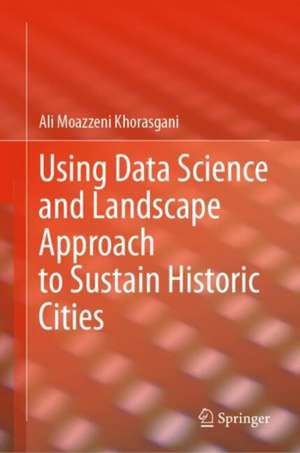Using Data Science and Landscape Approach to Sustain Historic Cities
Autor Ali Moazzeni Khorasganien Limba Engleză Hardback – 2 oct 2024
Preț: 712.43 lei
Preț vechi: 890.53 lei
-20% Nou
Puncte Express: 1069
Preț estimativ în valută:
136.32€ • 142.71$ • 112.80£
136.32€ • 142.71$ • 112.80£
Carte tipărită la comandă
Livrare economică 01-07 aprilie
Preluare comenzi: 021 569.72.76
Specificații
ISBN-13: 9783031681608
ISBN-10: 3031681606
Ilustrații: X, 110 p. 22 illus., 21 illus. in color.
Dimensiuni: 155 x 235 mm
Ediția:2024
Editura: Springer Nature Switzerland
Colecția Springer
Locul publicării:Cham, Switzerland
ISBN-10: 3031681606
Ilustrații: X, 110 p. 22 illus., 21 illus. in color.
Dimensiuni: 155 x 235 mm
Ediția:2024
Editura: Springer Nature Switzerland
Colecția Springer
Locul publicării:Cham, Switzerland
Cuprins
Chapter 1 Introduction.- Chapter 2 Understanding Historic Cities.- Chapter 3 Evolution of Regeneration Development.- Chapter 4 Landscape Approach for Historic City Sustainability.- Chapter 5 Data Science for Historic City Analysis.- Chapter 6 Sustainable Development Strategies for Historic Cities.- Chapter 7 Conclusion: Integrating Landscape and Data Science Approaches.
Notă biografică
Ali Moazzeni Khorasgani is a Ph.D. student of landscape architecture at Tarbiat Modares University in Tehran, Iran, and he was a visiting scholar joining to landscape architectural department of the Illinois Institute of Technology in Chicago. Currently, Ali is assistant professor of architecture at South Dakota State university. He is also a researcher with publications on historic cities, garden cities, smart buildings, and ecological studies. He is passionate about exploring the relationship between people and their environment and how to create sustainable and livable spaces. Ali was born in Isfahan, a historic city in central Iran known for its beautiful gardens and architecture. He grew up surrounded by the rich cultural heritage of his hometown, which inspired him to pursue a career in landscape architecture. He graduated from Isfahan University of Art with a bachelor’s degree in architecture in 2012 and then completed his master’s in landscape architecture at Yazd University in 2017. During his studies, he participated in various conferences and workshops, where he presented his papers and projects on topics such as urban morphology, historic preservation, ecological design, and smart buildings. He also collaborated with other researchers and professors on various research projects.
Textul de pe ultima copertă
This book comprehensively explores sustaining historic cities using a landscape approach and data science. The author offers valuable insights for professionals and enthusiasts interested in preserving and developing urban heritage through a data driven approach. Drawing on the synergy between landscape architecture and data science, the book delves into the intricate interplay between historical, cultural, and environmental factors in urban settings. Readers will understand how to navigate historic cities' complex challenges through case studies, research findings, and practical methodologies. The book equips readers with innovative strategies for preserving the authenticity of these cities while embracing sustainable development practices. By blending theory and real-world applications, this book is a comprehensive guide for creating thriving, resilient, and culturally rich urban environments.
- Integrates landscape architecture and data science disciplines to tackle the complexities of sustaining historic cities;
- Offers a unique perspective that bridges the gap between heritage preservation and data-driven methodologies;
- Gives practical insights into how landscape and data science approaches have been successfully applied.
Caracteristici
Integrates landscape architecture and data science disciplines to tackle the complexities of sustaining historic cities Offers a unique perspective that bridges the gap between heritage preservation and data-driven methodologies Gives practical insights into how landscape and data science approaches have been successfully applied
